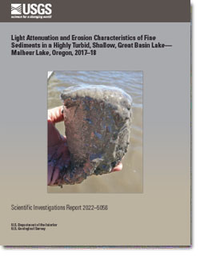Light Attenuation and Erosion Characteristics of Fine Sediments in a Highly Turbid, Shallow, Great Basin Lake—Malheur Lake, Oregon, 2017–18
Links
- Document: Report (4.2 MB pdf) , HTML , XML
- Data Releases:
- USGS data release - Phytoplankton data for Malheur Lake, Oregon, 2018-20
- USGS data release - Photosynthetically active radiation measurements collected at Malheur Lake, Oregon, 2017-18
- Download citation as: RIS | Dublin Core
Abstract
Malheur Lake is a large, shallow, turbid lake in southeastern Oregon that fluctuates widely in surface area in response to yearly precipitation and climatic cycles. High suspended-sediment concentrations (SSCs) likely are negatively affecting the survival of aquatic plants by reducing the intensity of solar radiation reaching the plants, thus inhibiting photosynthesis. This study was designed to determine the types of suspended material, the erodibility of the lakebed, the attenuation of photosynthetically active radiation (PAR) through the water column, and the effects of wind and precipitation on SSC.
Two sites in the lake were monitored for approximately 5 months during the summer growing season each year (2017–19). At these sites, turbidity, chlorophyll a fluorescence (a surrogate for concentration), and underwater PAR measurements were collected continuously, and discrete samples were collected every 2 weeks and analyzed for SSC, loss on ignition, and chlorophyll a concentration. Underwater PAR profile measurements were collected during site visits, and a nearby meteorological station recorded terrestrial PAR and wind speeds.
About 18 percent of suspended material in the water was organic and mostly detrital. Nearly 100 percent of all suspended material was fine material (less than 63 micrometers), and more than 90 percent of the surficial lakebed material was fine material. The high concentrations of fine material in the water column can be expected to strongly attenuate light.
SSC was significantly higher at both sites in 2018 compared to 2017 and 2019; the interannual differences were mostly due to the lower amount of precipitation in 2018, which resulted in shallower lake depths. Three years of SSC values multiplied by water depth showed a seasonal pattern: concentrations were often highest in early spring, lowest in summer, and intermediate in autumn.
Episodic wind events with speeds of 5–10 meters per second caused rapid increases in turbidity above background that lasted for a few days. However, a baseline SSC value multiplied by water depth (estimated to be 0.11 kilograms per square meter) was present between wind events and even under ice, suggesting a persistent suspension of very fine, highly erodible material. Terrestrial and underwater PAR measurements were used to develop a relation between PAR attenuation and turbidity that can be used in modeling restoration scenarios. Calculated bottom shear stress caused by wind-generated waves ranged from 0 to 0.4 pascals (Pa). Erosion experiments indicated variability in the bottom sediments from the two lake sites, but much of the lakebed is highly erodible at a threshold of 0.05 to 0.1 Pa.
Restoration actions may target the persistent turbidity (for example, the use of flocculation) or transient turbidity (for example, construction of wave-reduction barriers), with a goal of attaining approximately 36 micromoles photons per square meter per second of PAR at the lakebed to promote emergence of sago pondweed and other desirable plants. Currently, that threshold often is reached from 4 to 34 centimeters (cm) below the water surface in 1 meter water depth, depending on wind conditions, but halving persistent turbidity would increase the upper end of the range to 55 cm. Additional studies regarding the effects of (1) sediment drying on resuspension and (2) nutrient inputs and internal cycling on phytoplankton populations would help determine the most appropriate restoration strategies.
Suggested Citation
Wood, T.M., and Smith, C.D., 2022, Light attenuation and erosion characteristics of fine sediments in a highly turbid, shallow, Great Basin Lake—Malheur Lake, Oregon, 2017–18: U.S. Geological Survey Scientific Investigations Report 2022–5056, 51 p., https://doi.org/10.3133/sir20225056.
ISSN: 2328-0328 (online)
Study Area
Table of Contents
- Acknowledgments
- Abstract
- Introduction
- Purpose and Scope
- Interannual and Seasonal Patterns in Optically Active Particles, 2017–19
- Relation Between Optically Active Particles and Wind, 2017–19
- Light Attenuation as a Function of Optically Active Particles
- Measurement of Critical Shear Stress
- Light Attenuation by Persistent and Transient Turbidity
- Summary
- References Cited
- Appendixes 1–4
| Publication type | Report |
|---|---|
| Publication Subtype | USGS Numbered Series |
| Title | Light attenuation and erosion characteristics of fine sediments in a highly turbid, shallow, Great Basin Lake—Malheur Lake, Oregon, 2017–18 |
| Series title | Scientific Investigations Report |
| Series number | 2022-5056 |
| DOI | 10.3133/sir20225056 |
| Publication Date | July 21, 2022 |
| Year Published | 2022 |
| Language | English |
| Publisher | U.S. Geological Survey |
| Publisher location | Reston, VA |
| Contributing office(s) | Oregon Water Science Center |
| Description | Report: x, 51 p.; 2 Data Releases |
| Country | United States |
| State | Oregon |
| Other Geospatial | Malheur Lake |
| Online Only (Y/N) | Y |


